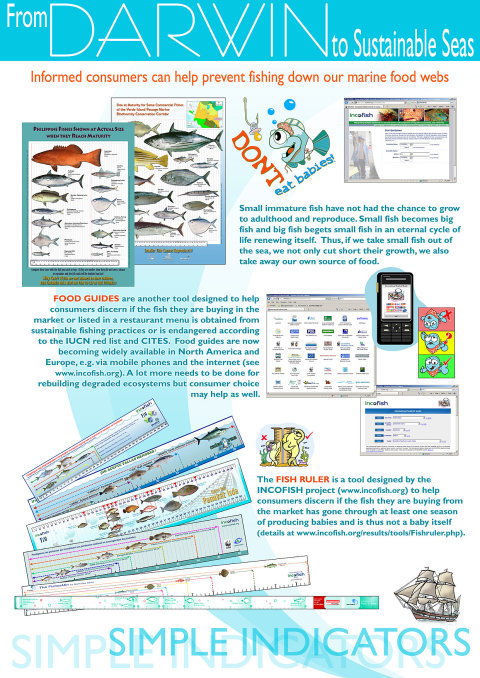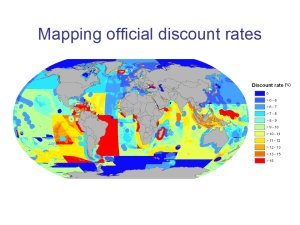Poster 6: Simple indicators
 No university education is needed to understand that fishing baby fish which have not been able to grow to a size where they can reproduce at least once can not be sustainable. But how do we know whether we have a baby fish in front of us in the net or in the market?
No university education is needed to understand that fishing baby fish which have not been able to grow to a size where they can reproduce at least once can not be sustainable. But how do we know whether we have a baby fish in front of us in the net or in the market?
Thanks to FishBase you can look up that minimum size 'at first maturity' for all fishes used by humans and for the full range of temperatures in which they survive and which influence how they grow. Not everybody knows as yet about FishBase or has access to the internet all the time.
Thanks to the INCOFISH research project, posters and fish rulers for common fishes have been developed and disseminated in several countries to help people identify this minimum length even if there is no access to the internet. A selection of these is shown here – such activities have been particularly sustained in Peru and amplified in Germany thanks to a media campaign of a consumer protection agency, using the research results.
Food guides are another tool designed to help consumers discern if the fish they are buying in the market or listed in a restaurant menu is obtained from sustainable fishing practices or is endangered according to the IUCN red list and CITES.
Food guides are now becoming widely available in North America and Europe, for example, via mobile phones and the internet. A lot more needs to be done for rebuilding degraded ecosystems, but consumer choice may help as well.
There are also little-noted, yet major economic factors at work. They have been described and analysed by Rashid Sumaila and others, e.g. economic behaviour that discounts the future too much, taking small benefits now at the expense of future benefits and even putting the productiveness of ecosystems into jeopardy.
In a nutshell, it goes like this:
- When we take too much and too small fish out of the sea, we are really grabbing a small benefit today, because we do not wait for the fishes to grow a little bigger to produce a much bigger benefit.
- Economists call that a discount rate. It is like a negative interest rate on a capital to harvest in the future. If we use a high discount rate, it makes more sense not to wait and get a much lower, but immediate gain. Conversely, if the discount rate is low, it makes sense to invest long-term into the future.
- When we invest in the education and well-being of our children today and for many years, we do that even if they do not get a big material value out of it. Yet we may even constrain our own consumption today so that our children can live well tomorrow because as parents, we do not count our children’s future incomes as ours.
 In largely public spaces, such as the sea, economic operators can be irresistibly tempted to overexploit, especially if banking interests (the ‘other side of the coin’ of discounting) are much higher than nature’s intrinsic capacity for renewal. In such areas of the world, it is particularly important to create large marine protected areas (MPA) as an insurance policy for future benefits. The world maps compare the two. MPAs are particularly important, where discount rates are in the orange to red (from Sumaila, 2009).
In largely public spaces, such as the sea, economic operators can be irresistibly tempted to overexploit, especially if banking interests (the ‘other side of the coin’ of discounting) are much higher than nature’s intrinsic capacity for renewal. In such areas of the world, it is particularly important to create large marine protected areas (MPA) as an insurance policy for future benefits. The world maps compare the two. MPAs are particularly important, where discount rates are in the orange to red (from Sumaila, 2009).Other factors come into play as well. When governments hand out subsidies to lower the cost of fuel, boat building, and efficiency increases, they enable fishing operations well beyond what the ecosystems we know can sustainably support.
 These subsidies have been estimated by the World Bank at US$ 11 billion/year in Asia, US$ 5 billion in Europe and US$ 4.5 billion in Latin America and the Caribbean.
These subsidies have been estimated by the World Bank at US$ 11 billion/year in Asia, US$ 5 billion in Europe and US$ 4.5 billion in Latin America and the Caribbean.All this goes to show that consumer choice can be important, but it alone can not solve these deeper problems.
Source of economic analyses:
Sumaila, U.R., 2009. Economics for sustainable oceans: Science for empowering solutions. Presentation to the EU Sustainability Conference, 27 May 2009, Brussels, Belgium.








